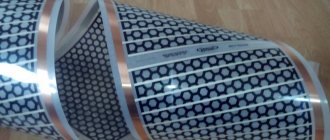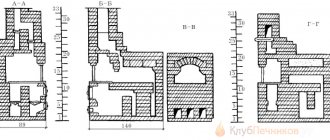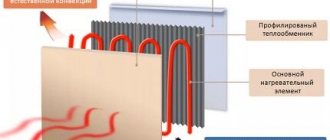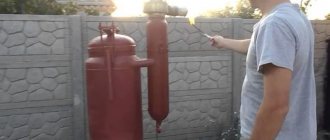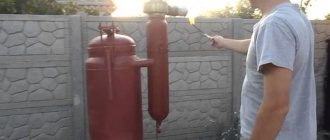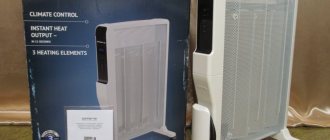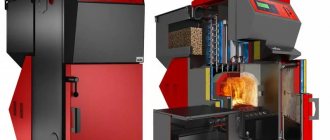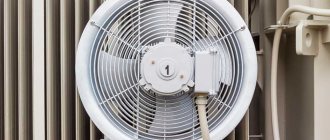Design and principle of operation of steam-drip heaters
This type of heater belongs to the group of “electric convectors”, that is, to heating devices, the operation of which initiates convective air flows in the heated room - the air in contact with the body of the unit heats up and rises, being replaced by a colder one.
Movement of convective currents initiated by a wall heater
The basis of the design of steam-drip heaters is a needle-type heating element. The tubular heater is mounted in the lower part of a sealed cast iron, steel or aluminum tank with water, ethanol or methanol, filled above the level of the heating element, the needle-shaped design of which does not require a large amount of liquid.
Schematic cross-sectional representation of the operation of a vapor-drip heater
The container in the PKN body is installed at an angle - the deviation of the plane of its base from the horizontal is approximately 20 degrees.
When the device is turned on, the water is heated by the heating element to boiling temperature within a few minutes and begins to evaporate, filling the free volume of the container with steam.
Hot steam under pressure, contacting the metal walls at the top of the tank, condenses on them, releasing thermal energy. Due to the high thermal conductivity of the metal, heat is transferred to the layers of air closest to the heater, initiating convection in the room, and the condensate in the tank flows along the inclined walls to its lower part and, again heated by the heating element, evaporates again.
Scheme of coolant circulation in a vapor-drip heater
Thus, two coolants are involved in the heat transfer process - water and steam, but the temperature of the liquid does not exceed 100 degrees, and the steam in the tank can heat up to 120, so the upper part of the PKN is always hotter during operation.
To increase the intensity of heat transfer in most PKN models, the upper part of the liquid reservoir is made in the form of multi-section blocks of narrow sections with additional external fins, which significantly increases the heat transfer area.
Important! The volume of the vapor-drip heater tank, free of liquid, is filled with technical vacuum, so the transition of the coolant from liquid to steam when heated occurs without boiling, that is, silently.
general description
A vapor-drip heater, reviews of which you can read below, is essentially a heat accumulator that concentrates a high-temperature coolant liquid. Even if the power is turned off, the coolant will generate heat for some time. This is the main distinguishing feature of the described type of heater from other electrical analogues, which cool down after being disconnected from the AC mains. A steam-drip heater has a coolant inside, the temperature of which can vary from 90 to 120 degrees. These modern devices have high-precision automatic units, through which you can adjust the temperature regime and operation of the device. The automation is quite easy to control; the user can figure it out on his own.
Technical characteristics and types of steam condensate heaters
The main criterion when choosing a PKN is the power required to heat a room of a specific area and volume. For household models of steam-drip heaters, this parameter ranges from 0.5 to 2.0 kW. Accordingly, in regions with a temperate climate, if there is effective external insulation of the building envelope, a PKN with a power of 1.5 kW will provide heating for a room of up to 15 square meters.
Options for the location of wall-mounted PKN in residential premises
Designing various models of steam-drip heaters requires an accurate calculation of the ratios of the power of the needle heating element, the surface area of the unit body, taking into account the fins and the amount of coolant used in the tank.
The maximum PKN power of 2 kW was chosen for safety reasons. Based on this value, the volume of the tank, the amount of liquid poured into it, and the heat transfer area are calculated. The ratio of these parameters should ensure effective steam generation in the container at a safe steam pressure (no more than 0.07 mPa), a housing surface temperature of no more than 115 degrees, and the location of the needle heating element is always below the liquid level - even when the heater is operating in maximum normal mode.
Important! Correctly performed calculation of the ratios of the power of the heating element, the amount of coolant, the volume of the tank and the heat transfer area of the housing makes it possible not to equip the PKN with a safety valve for releasing excess pressure. At the same time, for safety reasons, devices with a power above 1.5 kW are manufactured with increased strength characteristics and are intended mainly for industrial premises.
Steam-drip heaters are multi-section batteries with an electronic control unit, with a power of 1.5, 0.9 and 0.5 kW.
Steam-drip heaters, as mentioned above, are divided into household devices and units for industrial use.
Devices for industrial use are more powerful and, accordingly, their dimensions are larger. When producing such units, aesthetics are relegated to the background, giving way to operational efficiency, housing strength and security of the control system, as well as the power cable.
Steam condensate heaters for industrial use
However, even industrial steam-drip heaters of modern models have an above-average class of exterior finish, which allows them to be used in everyday life without damaging the interior of the room.
Steam condensate heaters of increased power BHeat Air 3000 with a power of 3 kW for industrial use - heating rooms up to 30 sq. m.
Modern PKN heaters, both for domestic and industrial purposes, are equipped with a safety system (automatic shutdown when the bimetallic plate overturns or overheats) and temperature control - a thermostat that operates on the basis of data from a temperature sensor, either standard or additionally installed with your own hands in the actual zone of the room - according to When the set temperature in this zone is reached, the heater will turn off.
Steam-condensate heater with an electronic control system unit equipped with a liquid crystal display
Based on their location, PKN models are divided into floor-mounted, wall-mounted and universal. The principle of operation of devices of all these designs is the same; heat transfer from the units is produced by both sides of the panel.
Floor-standing units are equipped with support legs that provide a stable position on a horizontal plane, or a platform with wheels that facilitate movement.
Important! If a permanent location has been determined for the unit, but there is a fear of tipping over, then the supports can be fixed to the floor with self-tapping screws after dismantling the wheels.
In the event of an unexpected overturning of the heater, an automatic network disconnection device will operate, and the relatively low temperature of the housing will not cause a fire.
Floor-standing model of a steam-drip domestic heater with holes in the supports for fastening to the floor with self-tapping screws
Wall-mounted models have holes on one side of the panel for brackets that secure the unit to the wall. The design and size of the brackets ensure that the PKN is located at a distance of 7-10 cm from the supporting base, which reduces the thermal effect of the heater on the wall and does not interfere with air convection from the back of the device. The section of the wall located behind the installed heater must be additionally equipped with thermal protection made of heat-resistant material.
Wall mounted steam condensate heater
The design of the PKN with a universal location allows you to install support legs on them or mount them on the wall. The effectiveness of a particular method of application depends on the specific operating conditions.
PKN models for universal placement - for use on the floor or placement on the wall
Potbelly stove using waste oil
Furnaces that operate using waste motor or transmission oil are widely popular. The advantages of such furnaces are reliability, efficiency in terms of consumption and unnecessary use of used oil. The drip stove is considered the most economical due to the characteristics of the fuel supply, but it is difficult to make on your own.
Stove-dripper
The drip stove works due to the fact that the ignited waste in the first tank releases flammable gases, which mix with air in the second tank and ignite again, reaching very high temperatures (about 800 ° C).
It is best to purchase a ready-made design. But if you want to try your hand at such a thing, then photo 2 shows a drawing according to which the assembly is carried out. Instead of a 180x180x6 pipe, a gas cylinder is often used (before cutting the cylinder, you should fill it with water or slowly drill a hole in the bottom and pour out the contents).
To automate the process and create a drip system, you need to filter the waste by passing it through a hose, at the end of which a full filtration automobile filter is installed.
You also need to select a fuel pump that will supply the required amount of fuel. You can use a piece of hose from a dropper with a regulator, put it on the lower fitting and control the fuel supply.
A drip stove can also be used to heat water if a heat exchanger with a removable container is installed in the upper part. Such a dripper stove can also be used for heating a room if you connect the house’s water heating system to it and equip it with a pump to circulate water through the system.
It is worth mentioning such a heater as a diesel stove. Often used in homes where it is impossible to implement another type of heating. The characteristics of a diesel fuel stove are similar to a gas boiler. It has high efficiency and can be converted for gas consumption. True, it requires timely maintenance and the availability of high quality fuel. A diesel stove is more expensive and harder to create, so the designs described above are good alternatives. published econet.ru
About the advantages and disadvantages
A steam-drip heater is an electric heating device, but the process of transferring thermal energy from the heating element to the heating surface is carried out in it using steam, just like the process of heat transfer in steam heating systems. Therefore, steam-drip heaters have the same advantages and disadvantages as a steam heating system:
We recommend: UPS for a boiler - we understand the nuances of choosing an uninterruptible power supply for a gas heating boiler
Speaking about the disadvantages, it should be noted that steam devices cannot be considered safe, and when choosing them for heating a house, it is better to install such devices in a safe place.
Nuances of the work
A cover is installed on the metal pipe, to which a pipe of not too large diameter is fixed. On the other hand, it is necessary to prevent air from entering. The result should be a design that allows you to regulate heat generation. The device can use not only water as a heat agent, but also other liquids such as low-boiling oil.
The master must create a steam-condensate sealed housing, which is installed on support posts. You must create a heating chamber with liquid, inside which is installed a housing of an electric heating element with conductive leads. They should be fixed to the end wall of the housing; the heating chamber should be located at an angle to the horizontal so that the heating element is located in the chamber below the surface level of the heating agent.
How it works: device and principle of operation
The vapor-drip heater consists of the following elements:
- heat exchanger, which is insulated inside the device;
- from an electric heating device located at the bottom of the heater;
- block with control system.
When the heater operates, it undergoes the process of converting water into steam. Let's take a closer look at the operating principle of a vapor-drip heater:
- The heating element, which is powered from the network, heats the water;
- under the influence of heat, water turns into steam;
- the rising steam heats the body and gives off its heat to the room;
- after which the procedure is repeated, since water in the form of condensate again enters the heating element.
Economical home heating
They are slightly more expensive than conventional electric heaters and are almost as economical as gas heating.
A steam-drip heater is an electric heater powered by a 220V network and operating on the steam-drip principle.
Represents the following:
- Hermetically sealed heat exchanger - the coolant is reliably isolated inside the housing. (The possibility of leakage and the need to “top up” the coolant are excluded).
- Electric heating element located at the bottom of the heat exchanger.
- Coolant.
- Mounted unit with control system elements and controls.
The following process takes place inside the vapor-drip heater:
- An electric heating element heats the coolant.
- The coolant passes from the liquid phase into the vapor phase (therefore, vapor-drip heaters are also called heaters with variable coolant).
- The steam, rising, uniformly heats the heater body and, due to the difference between its own temperature and the temperature of the body (which is a priori always lower, since the body is in contact with less heated air in the room), condenses and transfers heat to the heater body and further into the room.
- As the coolant condenses, it rolls down the walls of the heat exchanger down to the heating element, where it is reheated and the whole process is repeated again.
Savings using steam-drip heaters are achieved due to:
- A small amount of coolant, the cost of heating which to transform into a vapor state is small.
- After the coolant is converted into steam, even less electricity is required - only to maintain the steam formation process.
- The steam condenses to a greater extent and gives off more heat in the coldest areas of the heat exchanger, which contributes to uniform heating and more efficient heating of the room - heat transfer is carried out from a larger area.
- Large heat exchanger area - the larger the heat exchanger area, the greater the heat transfer. Imagine that you spent the same amount of electricity heating a needle eye and a large heat exchanger. The eye of the needle is red-hot, but the heat from it is transferred to the external environment by an order of magnitude less. A large heat exchanger releases more heat without getting too hot because it disperses heat evenly over a large surface area.
- Applications of microprocessor control with temperature sensors. Allows you to control the operation of the heater in the most efficient mode with minimal power consumption and minimal load on the heating element.
Good to know: coolants in modern devices can be water, ammonia, ethanol, methanol.
The vapor-drip heater is a pipeless heating system. There is no need to install heating system pipes, install radiators, or equip a boiler room. To install steam-drip heaters, you only need to connect to a 220V network through a regular outlet.
In addition, if desired, you can heat only part of the house and set different temperatures in different rooms. Or, conversely, combine heaters into a group or several groups and manage them centrally.
Water in a steam-drip heater
As mentioned earlier, when a vapor-drip heater operates, water is heated inside a sealed cylinder. In this case, water acts as a coolant, which allows us to draw an analogy between steam drippers and water heating radiators. Probably, it was the participation of water in the operation of the heater and the transfer of heat from its source to the heating surface with the help of steam that became the reason for the name of these devices as pipeless heaters, but this is only the assumption of the author of the article.
It is understood that the operation of the heater is controlled automatically using a thermostat, which turns off the power supply when the air in the room is heated above a set value. At the same time, it is possible to control the heating process, choosing comfortable conditions and eliminating wasteful energy consumption.
Unfortunately, in the presentation of the NPO “Volgograd Energy Saving Technologies”, as well as in the technical documentation attached to it, the manufacturer does not provide any explanation regarding the amount of water used in the device and only refers to the fact that it (the amount) is determined by calculation.
Meanwhile, the cylinder design is not supplemented with a relief valve in the event of an uncontrolled steam formation process, which occurs, for example, when the thermostat fails and the heating element overheats. It can be assumed that the manufacturers’ assurances of the high reliability of the drip heater are somewhat exaggerated.
The presence of water in a steam-drip heater can cause its failure when the device is not working in winter in an unheated room: the water will freeze and simply crush the cylinder. True, manufacturers assure that this will not happen, citing the small volume of liquid used, but again, there is no specific information on this issue in the technical documentation.
Owner reviews
The vapor-drip heater, reviews of which will help you decide on your choice, has many advantages. According to buyers, such devices are characterized by a long service life, which is set within 30 years according to the manufacturer’s calculations. This quality is due to the fact that there is no air inside the closed metal structure, where the coolant liquid and steam are present. All this indicates that metal corrosion processes do not occur.
Among other things, this container cannot explode, since it contains a certain volume of water that does not completely fill the tank. The steam-drip heater, reviews of which will be interesting for any consumer to read, has another advantage, which is expressed in the absence of the likelihood of the device rupturing when the heating system is turned off. In this case, the electric heater may freeze, but this will not lead to negative consequences. According to buyers, this is due to a small amount of water inside, which can freeze when the temperature drops, and when the device is turned on, it defrosts again. Afterwards, the water continues to circulate in a predetermined cycle.
The steam-drip heater, reviews of which are often only positive, allows you to adjust and regulate the temperature in each room at the discretion of the owners. At the same time, it is necessary to install a device in each room, which allows you to save on energy consumption. Buyers also choose this equipment for the reason that it can be used in premises for a wide variety of purposes. Most often they act as an additional heating system. If we are talking about small buildings, then steam-drip heaters can be used as the main heating.
Home DIYers also like the fact that it is quite easy to install this device yourself. Traditionally it is placed under the window opening, although this is not the only option.
About the efficiency of a vapor-drip heater
In the advertising campaign to promote steam-drip heaters, special emphasis is placed on high efficiency of 98%. Indeed, if you compare these devices with water heating radiators (both contain water), the efficiency is really impressive, but when compared with electric heaters, which also have an efficiency of 96-98%, this device does not stand out in any way.
It is for this reason that you should not count on the highly efficient and economical operation of paradrip heaters: the thermal effect during their operation and the operation of any other electric heaters of equal power will be equal.
Indeed, steam drippers will provide more comfortable heat compared to traditional heaters, because the temperature of their heat exchanger is lower and is 100-120C.
But they are unlikely to be able to compete with the new generation of infrared heaters, the heat exchanger of which also provides a comfortable heat flow, and the devices themselves can also be attached to the ceiling surface, and this is a completely different approach to the issue of heating and the ability to create more comfortable conditions in the room.
Application
Steam-drip heaters are more suitable as an additional heating method. They can be used both in ordinary residential buildings and in industrial buildings, offices and hospitals. PKN is perfect for institutions that are characterized by intermittent, periodic use: clubs, country houses, hotels, recreation centers, etc. It can also be installed on a loggia.
However, the question arises about its high cost compared to other devices.
So. Opinions about steam-drip heaters are very contradictory. Some call it a “miracle of modern technology,” others are inclined to believe that conventional heaters are no worse, but are much cheaper.
We tried to evaluate the device as impartially as possible, and the choice, as always, is yours.
Operation and maintenance of vapor-drip systems
Steam-drip heaters do not require regular maintenance. The device is ready for use immediately after installation and connection to the power supply.
In order to fulfill the warranty obligations in full, it is not recommended to disassemble the device yourself. Detected deviations in the operation of the device are eliminated in specialized service centers.
Attention! Clean water or high-quality non-freezing liquid is used as a coolant.
Uninterrupted operation of the electrical appliance for a long time is ensured by proper care and compliance with fire safety measures.
Caring for the device consists of fulfilling the following requirements:
- Before leaving, you must disconnect the device from the power supply.
- Periodically wet clean the surface of the device. When cleaning, use a slightly damp cloth. Make sure the cabinet is completely cool before cleaning.
- For cleaning, it is not allowed to use rags with hard bristles.
- Cleaning products must not contain abrasives.
The manufacturer issues a warranty for each purchased model. During the warranty period, repairs are carried out at the expense of the manufacturer.
Principle of operation
Usually the device is produced in a typical size with a regular home battery, but their efficiency is much higher relative to the amount of heat generated.
This type of device can be briefly described as a heat accumulator. The principle of its operation is pulsed, however, this does not affect the temperature level that was set, and it must be maintained in the room. The device goes into shutdown mode at certain intervals, but half of the heat volume that accumulated during operation during the shutdown period continues to be released into the environment. Some models from imported manufacturers can heat up to a temperature threshold of 350°C.
The vapor-drip heater is classified as an advanced device that has a heat exchange system at the heart of its operation. But this particular type of heater has significant differences from other similar equipment. The general operating principle of the device can be divided into several processes:
- water is heated by electricity;
- characterized by a process in which the coolant changes its state of aggregation to the level of steam and simultaneously releases thermal energy;
- due to the condensation process, the entire volume of coolant is returned back to the system;
- the sequence of processes has cyclical repetitions.
The operation of a vapor-drip heater mainly depends on the heat pipe. Its functions and characteristics can be described as follows:
- This element of the device is a conductor and transfers heat from the zone in which heating occurs (heating zone) to the one that is not yet heated (heating zone).
- It has a high level of thermal conductivity, exceeding silver and copper in this parameter.
- Transfers about 90% of the heat energy to the condensation zone thanks to the previous feature.
- Due to the fact that the tube has a capillary effect, used in modern elements, the movement of liquid condensate occurs through the capillary network inside the device.
- The cavity of the tube contains porous materials such as wick or loose ceramic.
- Modern designs contain water, ethanol, methanol or ammonia as a coolant.
- As for the efficiency of the heating element, it depends on the size and shape of the element, its properties and the value of the heat transfer coefficient.
Steam-drip type heaters are classified as pipeless heating systems. In addition, the owner of such a system is given the opportunity to regulate the operating mode of the device and set the required temperature, which can be selected for each individual case. It also allows you to control costs and be independent of the central heating system and their requirements.
In a closed system with an infinite number of cycles, electrical energy is converted into thermal energy.
If we describe the principle of operation of a vapor-drip heater in more detail, it will look like this:
| Start/end of cycle | Due to the action of the batteries, the water in the system is heated to the required set temperature. |
| Second phase | Boiled water forms steam, which is completely sealed in the cavity of the heating element. |
| Third stage | Thermal energy is generated and released into the surrounding space. |
| End/start of cycle | During the release of heat during condensation of steam, it begins to flow back into the heating element along the surface from inside the device, after which, in a similar cycle, it begins the process of converting back into steam. |
It is worth considering the fact that a distinctive advantageous feature of the vapor-drip heater system is that, thanks to the tube, it can transfer a much larger amount of thermal energy. In this regard, the small size of the installation of a vapor-drip heater allows it to produce a much larger volume of heat to heat the room than similar converter-type devices.
How effective are vapor-drip heaters?
Electric convectors have energy consumption that is equal to thermal power, this leads to certain design limitations. So 1 kW is capable of providing about 0.1 m2 of heat output, and the temperature of which the heating element will have will be approximately 350 degrees. When high-temperature air passes through a hot radiator, the atmosphere in the room becomes too dry, and this can cause some discomfort. Expanding the space will not help in this situation, since the temperature will also have to be increased.
Steam-drip heaters provide high heat transfer
As for vapor pressure, it has the following indicators:
- Thermal power relative to electrical power is 3 times greater;
- The efficiency level is 98%;
- The temperature of the coolant can vary from 70 to 120 degrees;
- The humidity in the room remains acceptable.
For this reason, such a heater can be installed in any room, even in a school or hospital. In addition, the installation can be used as a backup option, however, the price of such a unit is much higher than that of.
Advantages
- 2 times more economical than “conventional” electric heaters (convectors, oil radiators, etc.). With the same heat transfer, they consume 2 times less electricity.
- In case of power outages, they are programmed to turn on and work according to the last set program. During a long shutdown, there is no fear of “defrosting”.
- There is no risk of explosion or fire, since there is no excess pressure or flammable materials in the device, and the housing elements are made of fire-resistant materials - the aluminum radiator body reliably insulates the heating element and coolant; when the wiring or electronic elements catch fire, the body of the mounted unit emits carbon dioxide, which causes a fire is eliminated.
BHeat Air
They are easy to install, are not hidden behind walls or under floors, and therefore pose no threat of hidden damage that could damage your home.
They do not dehumidify the air and turn on independently after unexpected power outages.
Moreover, heating costs with these heaters are comparable to gas boilers and heat pumps. And the cost of purchasing them is not much higher than an electric convector. BHeat Air vapor-drip heaters are powered from a 220V network.
The table below will help you choose the right heating system.
From the table it follows that the BHeat Air vapor-drip heater represents the optimal solution based on a combination of factors. The golden mean between gas heating and “classic” electric heating.
Watch the video in which a specialist explains the operating features and advantages of using steam-drip heaters:
Where to start assembling an electric heater with your own hands
The most effective form for such a radiator is a pipe:
- provides maximum heat transfer;
- promotes the freest movement of coolant from the heating area to the heat transfer area.
Factory models look like a familiar radiator, consisting of several such pipes. At home, it is also rational to make a heater of a similar design.
Before you begin assembling the device yourself, carefully read the finished diagram and instructions for it, taken as a basis. Follow the instructions exactly as it concerns electricity. Pay increased attention to safety. For a vapor-drip heater you will need:
- pipe made of corrosion-resistant metal - copper, aluminum;
- a small diameter tube made of the same material;
- cover for it;
- water valve;
- wire made of corrosion-resistant metal;
- welding machine.
Attention! The design of a vapor-drip heater is simple, but it will require you to be able to use welding and have electrical knowledge. If you are not confident in your abilities, it is safer not to take on the construction of a homemade heater.
Assembling a steam-drip heater in stages
The whole process will require time, care, scrupulousness and diligence:
Externally, a vapor-drip heater resembles a regular radiator
- Take a prepared piece of pipe. Brew it tightly on one side.
- Close the section with a lid at the opposite end. A narrow diameter tube should be attached to it. Through it the heater will be filled with liquid.
- Attach a valve to the narrow tube. With its help, during operation you will control the gases accumulating in the device. The material from which the valve is made must be compatible with the material of the pipe.
- Assemble the electrical base of the heater according to the diagram. It involves the presence of a wick, most often made of stainless wire. However, aluminum is not suitable for these purposes. The elements are intertwined and welded. You can make a mesh out of foam or felt.
We recommend: Gas double-circuit boiler: what is it, single-circuit or double-circuit, with a boiler
Attention! A low-power heating element can be bought in a store. Choose a model with a temperature regulator.
Another version of a vapor-drip heater involves its manufacture on the basis of a ready-made water heating radiator, which has threaded holes. In order for such a device to be fixed in a vertical position, it should be attached to a frame with flat supports or legs (it can be welded from angle steel). The thread in such a radiator most likely will not match the thread of the purchased heating element. To combine, you will need an adapter. Sealant should be used in all connections. Careful assembly and careful operation will help you save up to 70% on the purchase of a factory model.
Battery-based vapor-drip heater
There are quite interesting schemes for the manufacture of this equipment. For example, a simple steam-drip heater can be made from an old cast-iron battery. The task here is simple - you need to build a heating element into it and fill it with water so that it covers the heating element. The design should be as tight as possible.
A homemade heater made from a heating battery will disappoint you with its long heating time, but will delight you with its long-term heat retention even after the device is turned off. The vapor-drop principle of operation will allow you to avoid an increase in pressure when heating water and rupture of the resulting apparatus when it freezes. That is, if you fill the battery with water to capacity, it will burst when it freezes.
A battery-based vapor-drip heater will become relevant for a country house, which is often left without residents and can freeze through in the winter.
The task of the designer of a steam-drip heater is to integrate a heating element inside an old radiator. But one more problem needs to be solved - to build a thermoregulation system. The easiest way is to purchase a heating element with a built-in thermostat. But it will monitor the water temperature, and we don't need that. Therefore, we choose the second option - we buy the simplest mechanical room thermostat.
A room thermostat monitors the temperature in the room. Being equipped with a contact group, it will ensure that the heating element is turned off. You can also implement manual temperature control using an ordinary switch. Please note that thermostats and switches must be able to withstand the voltages and currents in the electrical circuit.
From steel pipe
Before you start making a vapor-drip heater, you need to find a ready-made diagram and carefully study it. In addition, it is important to ensure maximum safety, since the slightest inaccuracy can lead to electric shock.
To make your own vapor-drip battery, you will need the following materials and tools:
- a piece of pipe made of metal that is resistant to corrosion (aluminum, copper and others);
- a small diameter tube made of a similar material and a lid for it;
- water valve;
- a piece of stainless alloy wire;
- welding machine.
All materials used can be easily found in any hardware store in the locality. They are quite expensive, but the device will need a small amount of them.
The work of assembling the heater is simple, but requires the ability to work with welding and electricity. If you are not sure that you can cope with such a task, then it is better to seek help from a specialist or abandon the homemade device.
Video about an electric heater:
Assembling the heater is carried out in several simple steps:
- A pre-prepared piece of metal pipe is carefully welded on one side. In this case, the seam should be tight and as smooth as possible.
- A lid is attached to the opposite edge.
- A small diameter tube is mounted to it, which will serve to fill the apparatus with coolant.
- A water valve is connected to it. Thanks to it, you can not only control the flow of liquid into the device, but also monitor the accumulating vapors. The valve must be made of an alloy compatible with the material of the pipe on which it is installed.
- The electrical part of the device is assembled according to the selected circuit. It must have a stainless wire wick.
Self-production of PKN
The high cost of steam-condensate heaters, despite the apparent simplicity of the principle of operation, gives rise to the temptation to make such a unit yourself, taking into account the modern availability of materials, components and tools.
Indeed, today steam-drip heaters are often made by hand - the materials and components for their assembly can be easily found on sale. But it is not realistic to produce such units at home only after reading the instructions and recommendations - there are quite a lot of designs of such devices, and the manufacturing technology of each has individual characteristics. In this case, it is necessary to have not only general skills in installation and welding, but also practical experience specifically in the manufacture of PCNs.
In addition, assembling a low-power vapor-drip heater is impractical - there are many other types of inexpensive heating devices, industrially manufactured, that will cope with heating a home better and safer. And a homemade high-performance unit is not so aesthetically pleasing that it can be used to heat a home.
Homemade PKN from a steel pipe with a 500 W heating element
The heating register shown above, operating on the steam-drip type, can serve as a visual aid to the question of how to make a PKN yourself
The unit is assembled from four “stream” fragments made of a steel pipe with a diameter of 50 mm and plug-plates made of sheet steel. A heating element is installed in the lower “stream”, equipped with a pipe. At the top of the register there is a plug with a valve through which a mixture of water and antifreeze was poured into the radiator and air under pressure was released when the device was first turned on.
Schematic cross-sectional representation of the PKN device
The lower “stream” is filled with coolant, which evaporates when heated. The steam fills all the free space of the “streams”, gives off heat to the walls of the radiator and condenses on them, then flowing back down to the heating element.
The design of the PKN may be simpler, but this does not eliminate the need for specific professional skills.
Homemade PKN single-strand steel pipe design
Important! The lack of vacuum in a homemade radiator causes boiling of the coolant, accompanied by a certain noise when the unit operates.
Build and Upgrade Processes
To assemble a vapor-drip heater, you will need a grinder and a welding machine. We cut off the main pipe (we will use one pipe), set it at a given angle. We align the lower part vertically and brew it - the heating element will cut into it. We also weld the upper part, but do not forget to weld a tube with a ball valve to it. Or better yet, two taps - water will flow in through one, and the air it displaces will come out through the second.
You can also pour water into the heater immediately after brewing the lower part and inserting the heating element. Make sure that the coolant covers the heating element completely, otherwise it will fail. That is why a self-made device must be sealed to prevent loss of coolant and exposure of the heating element.
We place the finished structure in a heated room near a window. Let's start testing - connect the heater to the mains. After a few minutes, the water will boil, steam will begin to be released, which will condense in the upper cold part of the pipe and flow back down the inclined wall. The vapor-drip principle of operation will ensure rapid heating of the device with minimal losses.
To increase heat transfer, you can play with the amount of water (relevant for those who have provided valves). Its quantity is not specified anywhere, so you need to act experimentally. There is another way to increase heating efficiency - it involves creating a thin metal casing with lower and upper slotted holes. In this case, the vapor-drip heater will create convection currents that quickly warm up the room.
We recommend: How to descale a boiler at home, do-it-yourself water heater cleaning
When creating a vapor-drip heater with your own hands, be careful - use a welding mask and protective gloves. Pay special attention to electrical connections - only reliable connections without sparks or other special effects. Do not forget to connect and ground the assembled device.
What is PLEN heating
Gas has reached many cities and villages in our country, but not all of them yet.
We will talk about the heating option without gas. We have been talking about gasification of the entire country for so many years that it is already indecent to talk about it. Gas pipelines are slowly but surely penetrating into the most remote corners of Russia. And it begins to seem that every home has access to blue fuel. However, this is far from true - gas is not available everywhere. Moreover, sometimes it does not exist even in completely gasified areas. Therefore, people are forced to use alternative heat sources.
With electrification, the situation is simpler - electricity has indeed reached even the most remote corners of Russia, delighting millions of consumers. Therefore, in some settlements, electricity remains the only source of energy for heating residential and non-residential premises. But electric heating has one small drawback - it is extremely uneconomical, which leads to enormous financial expenses.
Classic electric boilers allow you to heat any type of room without any problems. They have high efficiency, but the high cost of one kilowatt and high consumption force consumers to pay huge amounts of money for heat. And the larger the heated area, the higher the costs. Modern technologies are the salvation of the situation - this is PLEN infrared heating, characterized by economy and high efficiency.
What is PLEN heating and what is this equipment? The PLEN heating system operates on the principle of infrared heating. Here, special film electric heaters are used that generate infrared radiation. This is what ensures high-quality and relatively quick heating of the premises. How does PLEN heating equipment work?
Film heaters are installed on the ceiling, behind a decorative covering. They themselves do not emit heat, but only heat objects around them.
- installation area necessary for fixing the film;
- heating (resistive) strips are the working fluid of the film;
- foil - reflects heat in one direction.
Here we can find the wires with which the film is connected to the electrical network.
The infrared radiation created by PLEN film penetrates the room and heats the objects in it - furniture, floors and much more. Some time after turning on the equipment, the rooms become noticeably warmer. To regulate the temperature, thermostats are used, through which heating elements are connected.
PLEN is built on the principle of a multilayer “sandwich”, and the main working fluid is thin resistive strips through which electric current flows. The heating temperature is +40-50 degrees. Thanks to this, PLEN is fire safe. The infrared radiation created by the resistive strips is directed strictly in one direction, which must be taken into account during installation. The film itself (PLEN) is placed on the ceiling.
In terms of its operating principle, PLEN resembles film for infrared heated floors, but differs from it in its design and installation features.
As we have already said, PLEN film placed on the ceiling generates infrared radiation. Reaching floors, walls and any objects, the radiation heats them, as a result of which they begin to emit heat. A notable advantage of this type of heating is that the air temperature near the floors is slightly higher than the temperature in the center of the room. This will appeal to those who constantly have cold feet.
Safety precautions
Any homemade or factory-made device, especially one powered by electric current, poses a threat to human life and health. Therefore, when manufacturing it, you should provide for all possible emergency situations and try to reduce the risk of their occurrence.
To protect yourself from unpleasant situations, you must follow safety rules
Basic safety measures when operating steam-drip batteries:
- Before turning on the device, it is necessary to study in detail the principle of its operation.
- It is prohibited to use the heater at voltages that do not correspond to the technical characteristics of the device.
- It is not recommended to cover or block the device with any object. Such carelessness can cause overheating and damage.
- Do not place the vapor-drip heater next to pieces of furniture. High temperatures can harm them and ruin their appearance.
- It is strictly forbidden to use the device in areas where paint, fuel and other flammable materials are stored. Neglecting this rule can lead to fire and all the serious consequences associated with it.
- While the device is operating, do not touch it with your hands. Otherwise, there is a high probability of getting burned from the hot surface.
- If you need to move the device to another location, you must first disconnect it from the power supply and cool it to room temperature.
- Do not dry clothes on a heater.
- Avoid getting any foreign objects into the inside of the device.
- The heater can only be used far from water. In addition, even the slightest exposure to moisture should be prevented. If water accidentally gets on the device, you must immediately turn off the power and only then remove the liquid.
- It is prohibited to plug into a power outlet a steam-drip heater that has a damaged cord or plug. Otherwise, there is a risk of electric shock.
- It is not recommended to use extension cords.
More details about the vapor-drip heater:
A vapor-drip heater is a useful and necessary device in the household. With its help, you can quickly heat the room and make your stay as comfortable as possible. In addition, you can make such a device with your own hands. This will not only save money, but will also allow you to gain experience in similar work, which may be needed in the future.
General information
Such heating equipment is quite expensive, so many poor families prefer to make them themselves. To do this, you need to have not only some knowledge, but also the skills of such work. Only in this case will the drip-steam heater be of high quality and work efficiently.
Steam-drip heaters are very unpretentious to use; they will help create a cozy atmosphere in your home
Design and principle of operation
Such devices for heating residential premises are produced in different capacities (from 0.5 to 1.5 kW).
At the same time, they are very simple and have a similar structure to each other. Any type of steam-drip radiator can save the owner at least 10% of electricity. This indicator is achieved through the use of special devices with high accuracy and quality. This is interesting: making a powerful induction heater with your own hands.
Heater device:
- sealed heat exchanger, which is insulated inside the device;
- a heating element powered by electricity and installed at the bottom of the heating device.
- block with control system;
- electronic thermostat.
The heater is very simple and effective to use
. Despite the simplicity of the device, this device works very efficiently. It heats up quickly and transfers most of the heat to the room in which it is installed. Factory-made and self-made vapor-drip batteries are capable of heating an apartment, house or office. In the room where such a device is installed, you can quickly raise the temperature to +24°C.
Operating principle:
- As soon as the device is connected to the electrical network, the heating element begins to heat up.
- It gradually heats up and heats the water to a boiling point.
- Because of this, the coolant turns into steam.
- It rises and heats the body of the device.
- Then it condenses and quickly releases its heat into the room.
- The resulting drops of liquid flow down, and the process repeats again.
Advantages and disadvantages
Do-it-yourself vapor-drip heaters, like any other devices, have their advantages and disadvantages. They must be taken into account before starting work in order to protect yourself from possible negative consequences.
In the video, learn more about vapor-drip batteries:
The positive aspects of the device include the following:
- Simplicity of design. The heater does not contain complex components, which greatly simplifies and reduces the cost of the repair process in the event of any breakdown.
- Cheapness. Due to their small size and the absence of expensive parts, steam-drip boilers are relatively cheap. Even people with limited financial resources can afford such a heating device.
- Durability. These devices rarely break down and, with proper care, can last for quite a long period (up to 30 years).
- Environmental friendliness. The vapor-drip heater operates from the electrical network, so it does not emit any harmful substances into the atmosphere or the environment. In addition, it does not dry out the air and does not cause an unpleasant odor.
- Safety. The device operates at minimum pressure, which eliminates the possibility of depressurization or explosion. In addition, it is absolutely safe for humans.
- Resistant to corrosion. The device will never rust or lose its attractive appearance, as it is made from corrosion-resistant materials.
- Frost resistance. The steam-drip heater tolerates even the lowest temperatures well. The limited amount of water used prevents the possibility of rupture if the coolant completely freezes.
Steam-drip heaters, when treated with care, will delight you with special durability
In addition to a large number of advantages, the device also has disadvantages that are associated with its design and method of operation.
Among them it is worth noting the following:
- A device with such a device can operate on a minimum of electricity, but a vapor-drip heater uses it in much larger volumes.
- Unsafe combination of electricity and water.
- The efficiency of the device is significantly lower than the indicators declared by the manufacturers.
Application area
All types of vapor-drip batteries have found wide application in various fields. Thanks to them, a large number of residential and industrial premises are heated.
The devices are used in the following cases:
- for heating kindergartens and educational institutions;
- to maintain comfortable conditions during construction or repair work;
- for heating hotel rooms, country houses, loggias and balconies;
- for defrosting communications (water, sewerage in basements, wells);
- to maintain heat in places where people temporarily stay (sanatoriums, recreation centers, workshops, workshops, offices and others).
Using a steam-drip heater, you can provide a comfortable temperature in any room
Common models
Among the equipment that can be purchased in our country, there are several popular models. Among them, it is worth noting the following technique:
- BHeat Air-4 with a power of 0.7 kW. Energy consumption is 280 watts. With a small weight (5.7 kg) and dimensions (375x90x580 mm), it heats a room with an area of 7-21 m². This comfortable device is liked by customers for its efficiency.
- The BHeat Air-6 kilowatt heater is larger, heavier and uses more energy (400 W). But the size of the serviced premises is also larger - from 10 to 30 m².
- The power of the BHeat Air 2000 unit is 1 thousand watts, dimensions are 890x106x245 mm, weight is 12 kilograms. The heated area is close to 20 m². This model has a function to maintain a given temperature, which allows you to save resources, as well as an electronic control system. The device is protected from overheating and freezing.
- About 30 square meters will be served by the BHeat Air 3000 product with dimensions 1310x106x245 mm and weight 18 kg. Its power is 1500 watts. It has modes for supporting parameters and saving the latest settings.
- The thirty-kilogram BHeat Air 5000 unit is designed for 2.5 kilowatts and an area of up to 50 m². It weighs 30 kg. It is distinguished by simple installation and the ability to control via radio channel.
- The compact heater PKN-3−0.5−4 will efficiently heat up to 17 m² of area.
- Up to 20 m², this figure will increase for the PKN-3−0.6−6 model by 0.6 kilowatts. Its size is 550x600x80 mm, weight - 8 kilograms.
- The PKN-3−1.2−12 device has a power of 1.2 kW, weight 15 kg and dimensions 1000x600x80 mm. The heated room can be up to 40 m² in area.
A vapor-drip heater will provide comfortable conditions in the house and significantly save money due to energy efficiency. The absence of expensive repairs and service will reduce family expenses, and the long service life will not necessitate the purchase of a new device. All this speaks in favor of convenient and effective new generation devices.
Making a wick
When choosing a wick, it is necessary to take into account that the material at its base must be compatible with the working fluid.
When making a vapor-drip heater with your own hands, you should equip it with a wick. The most commonly used wick is a woven wire mesh. This element can be woven from monel, copper or stainless wire. It is not recommended to use aluminum mesh to make the wick, as it is quite difficult to weave. Experts recommend using stainless steel mesh for manufacturing. The elements should be connected to each other using the diffusion welding method. This will allow you to form a fairly strong solid wick that bonds to the walls of the metal pipe body. The master should carry out diffusion welding at a temperature of 1150 degrees in a vacuum oven. It is not always possible to create such conditions in everyday life, which is why if you decide to make a vapor-drip heater with your own hands, then the implementation of several elements should be entrusted to specialists. The wick can be made of felt, as well as foam-like material. You can find metal and ceramic felt on sale.
Comparison with other heating systems
If you are making a comparative comparison of equipment intended for heating rooms for efficiency, you can refer to the data in the table. It indicates the size of the costs at the stage of installing heating equipment (the calculation is carried out relative to a house with an area of 150 m2).
| Energy source | Internal equipment costs | External equipment costs | Construction costs | Total | Boiler room area, m3 | |
| A gas boiler | Gas | 114 000 | 60000 | 140000 | 314000 | 10 |
| Liquid fuel | Heating oil | 103000 | 24000 | 140000 | 267000 | 10 |
| Electric boiler | Electricity | 120000 | 1000 | 140000 | 261000 | 10 |
| Heat pump | Heat from the ground, electricity | 224000 | 430000 | 340000 | 994000 | 10 |
| Steam-drip heater | Electricity | 204000 | 204000 | — |
Comparative characteristics of the amount of costs in total value for periods.
| Costs per season | Costs per year | Costs over three years | Average cost per kW | Costs per 1 m2 | |
| A gas boiler | 11340 | 325000 | 347680 | 3,06 | 2318 |
| Liquid fuel | 71820 | 338820 | 482460 | 4,25 | 3 216 |
| Electric boiler | 68040 | 329040 | 465120 | 4,1 | 3 101 |
| Heat pump | 18400 | 1012400 | 1049200 | 9,25 | 6995 |
| Steam-drip heater | 18900 | 222800 | 260600 | 1,6 | 1 225 |
Making a wick
When choosing a wick, it is necessary to take into account that the material at its base must be compatible with the working fluid. When making a vapor-drip heater with your own hands, you should equip it with a wick. The most commonly used wick is a woven wire mesh. This element can be woven from monel, copper or stainless wire. It is not recommended to use aluminum mesh to make the wick, as it is quite difficult to weave.
Experts recommend using stainless steel mesh for manufacturing. The elements should be connected to each other using the diffusion welding method. This will allow you to form a fairly strong solid wick that bonds to the walls of the metal pipe body. The master should carry out diffusion welding at a temperature of 1150 degrees in a vacuum oven. It is not always possible to create such conditions in everyday life, which is why if you decide to make a vapor-drip heater with your own hands, then the implementation of several elements should be entrusted to specialists. The wick can be made of felt, as well as foam-like material. You can find metal and ceramic felt on sale.
Price
The price depends on the power, simplicity of the device, and the area of the heated room.
The cheapest options are represented by the following models:
- BHeat Air-4 - 9,500 rubles.
- BHeat Air-6 - 10,400 rubles.
- Bheat Air 1000 - 10,500 rubles.
- Bheat Air 1500 - 12,000 rubles.
- PKN-3-0.5-4 - 12,100 rubles.
- BHeat Air 2000 - 12,240 rubles.
- PKN-3-0.6-6 - 13,200 rubles.
And more expensive options:
- BHeat Air 3000 - 16,200 rubles.
- PKN-3-1.2-12 - 16,500 rubles.
- Bheat Air 4000 - 22,100 rubles.
- BHeat Air 5000 - 23,490 rubles.
